Low profile: the Muxin Art Museum is a delicate lakeside addition
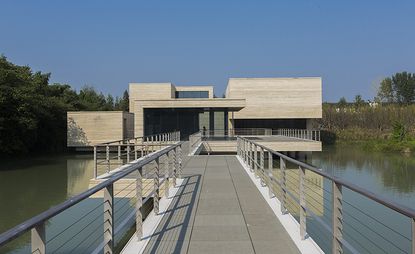
A collection of simple low-slung modernist cubes 'floating' above a lake in Wuzhen, China, is the latest cultural addition to the area's popular 'water-town' tourist resort, a maze of traditional canals with stone lanes and classic shop-houses about an hour's drive north of Shanghai.
The privately owned museum is dedicated to the artist, scholar, poet and writer Mu Xin (1927-2011) who was born in the area, imprisoned during the Cultural Revolution, and subsequently moved to the United States.
The 6,700 sq m building was designed by the New York-based architect Hiroshi Okamoto who, before co-founding OLI Architecture in 2010, worked with IM Pei on Doha's iconic Museum of Islamic Art, and the Miho Institute of Aesthetics in Japan.
According to Okamoto, reflecting a sense of local traditional vernacular while avoiding any hint of pastiche was key to the project. Here, this was achieved by placing a series of discrete volumes along an axis creating the sense of walking through the different levels and intimate spaces of a traditional Chinese village.
'We wanted to expand and contract space in a physical and experiential way while keeping the scale low,' explains Okamoto. Sixty percent of the building is at below grade with two stories above water.
The building's form may be understated but its dove grey concrete façade imprinted with the natural grain of timber boards (a nod to the local vernacular) is striking, particularly when illuminated at night. Okamoto says achieving the desired tone required numerous experiments while local craftsmen were specially trained to meticulously recreate the wood grain effect.
Inside, eight intimate galleries (including five permanent exhibitions showcasing Mu Xin's art and writing) have deliberately been kept somber reflecting the artist's preference for keeping his own home and studio darkened.
This makes the elegant light-filled stepped library overlooking a garden with a serene contemporary rockscape by the artist Liu Dan even more enticing. Two high walls comprising an intricate arrangement of alternating light and dark grey panels enclose the garden, reflecting the artist's trademark ethereal landscape ink and gouache paintings.

The 6,700 square meter building was designed by the New York-based architect Hiroshi Okamoto. courtesy of OLI Architecture PLLC
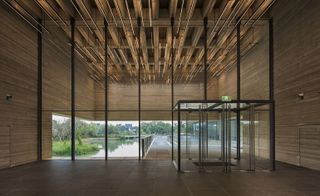
The architect aimed to reflect a sense of local vernacular while avoiding any hint of pastiche. courtesy of OLI Architecture PLLC
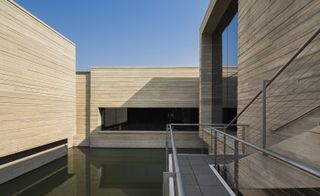
Two of the building’s storeys are above water level, but sixty percent of the structure is in fact underneath. courtesy of OLI Architecture PLLC

The building is made of dove grey concrete imprinted with the natural grain of timber boards. courtesy of OLI Architecture PLLC

Mu Xin, Untitled, Lithograph 38X56.5cm, 1989. Image courtesy of Mu Xin Art Museum
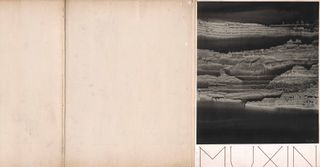
Mu Xin, The cover design Mu Xin made for his future catalogue, Paper, 53.5X102cm, dateless. Image courtesy of Mu Xin Art Museum

Mu Xin, Morning, Multi-layered Inks on Paper, 11.3X47.4cm, 2000. Image courtesy of Mu Xin Art Museum
INFORMATION
For more information on the museum visit the website
Wallpaper* Newsletter
Receive our daily digest of inspiration, escapism and design stories from around the world direct to your inbox
-
 The Eurovision stage for 2024 has been unveiled
The Eurovision stage for 2024 has been unveiledThis year's stage design aims to bring the audience into the performance more than ever before.
By Charlotte Gunn Published
-
 Ikea meets Japan in this new pattern-filled collection
Ikea meets Japan in this new pattern-filled collectionNew Ikea Sötrönn collection by Japanese artist Hiroko Takahashi brings Japan and Scandinavia together in a pattern-filled, joyful range for the home
By Rosa Bertoli Published
-
 Coming soon: a curated collection of all the new EVs and hybrids that matter
Coming soon: a curated collection of all the new EVs and hybrids that matterWe've rounded up new and updated offerings from Audi, Porsche, Ineos, Mini and more to keep tabs on the shifting sands of the mainstream car market
By Jonathan Bell Published
-
 Shigeru Ban’s mini Paper Log House welcomed at The Glass House
Shigeru Ban’s mini Paper Log House welcomed at The Glass House'Shigeru Ban: The Paper Log House' is shown at The Glass House in New Canaan, USA as the house museum of American architect Philip Johnson plays host to the Japanese architect’s model temporary home concept
By Adrian Madlener Published
-
 Ray Phoenix to rise in Arizona
Ray Phoenix to rise in ArizonaRay Phoenix housing project launches, designed by Johnston Marklee, who worked with Lamar Johnson Collaborative, for property experts Ray and Vela
By Ellie Stathaki Published
-
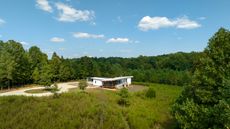 A low-energy farmhouse provides a rural escape in North Carolina
A low-energy farmhouse provides a rural escape in North CarolinaThis low-energy farmhouse is a net zero architectural re-set for a Californian client, an East Coast relocation for a more engaged and low-key lifestyle
By Jonathan Bell Published
-
 A Petra Island house rises from Frank Lloyd Wright's original drawings
A Petra Island house rises from Frank Lloyd Wright's original drawingsBased on Frank Lloyd Wright drawings, the cantilevering Petra Island Massaro House, located in New York’s Hudson Valley, is now open to visitors
By Craig Kellogg Published
-
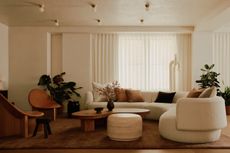 An Upper West Side apartment by General Assembly nods to its history
An Upper West Side apartment by General Assembly nods to its historyAn Upper West Side apartment in New York, born out of the reimagining of two neighbouring units, is refreshed by General Assembly for a young family
By Ellie Stathaki Published
-
 New York's Leica store echoes the brand's blend of heritage and innovation
New York's Leica store echoes the brand's blend of heritage and innovationLeica store throws open its doors in New York's Meatpacking District, courtesy of Brooklyn based Format Architecture Office
By Adrian Madlener Published
-
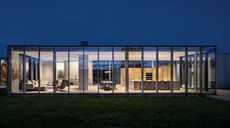 Hudson Valley Residence is a low-lying retreat that seamlessly blends into the horizon
Hudson Valley Residence is a low-lying retreat that seamlessly blends into the horizonDesigned by HGX Design, Hudson Valley Residence is a scenic home offering unobstructed views across the Catskill Mountains in Upstate New York
By Tianna Williams Published
-
 Boise Passive House’s bold gestures support an environmentally friendly design
Boise Passive House’s bold gestures support an environmentally friendly designBoise Passive House by Haas Architecture combines sleek, contemporary design and environmental efficiency
By Ellie Stathaki Published